Dysonica Plc: Financial Cost Analysis, Reduction Methods & Budgeting
VerifiedAdded on 2023/06/10
|16
|4897
|440
Report
AI Summary
This report provides a comprehensive analysis of Dysonica Plc's financial situation, focusing on cost determination, reduction strategies, and budget forecasting. It begins by classifying costs into fixed, variable, and semi-variable categories, further exploring marginal, absorption, and activity-based costing methods. Recommendations for cost reduction are provided, alongside a 12-month budget forecast up to April 2023. The report concludes with an analysis of Dysonica's performance against the forecasted budget, offering insights into the company's operational efficiency and financial stability. Desklib provides a platform for students to access this and other solved assignments.
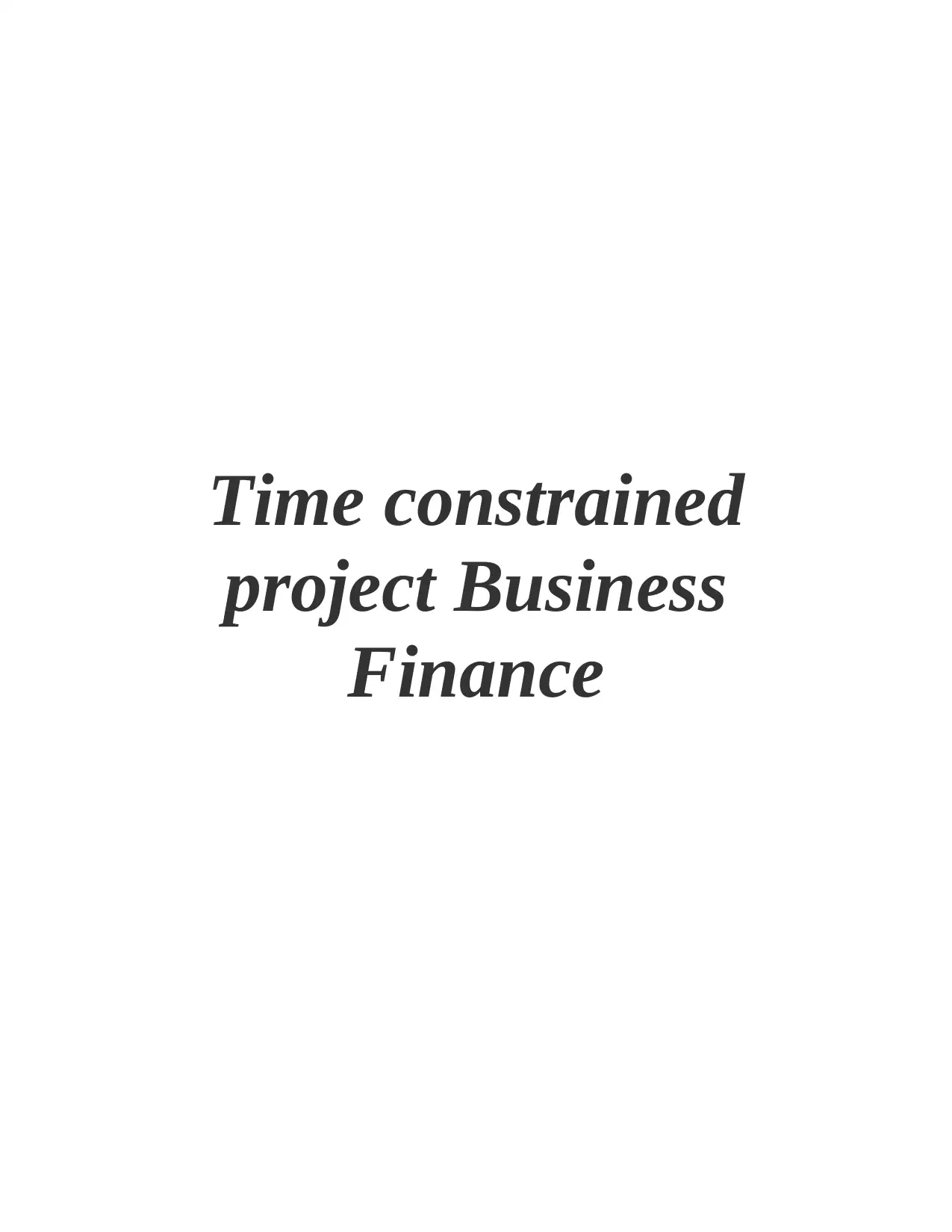
Time constrained
project Business
Finance
project Business
Finance
Paraphrase This Document
Need a fresh take? Get an instant paraphrase of this document with our AI Paraphraser
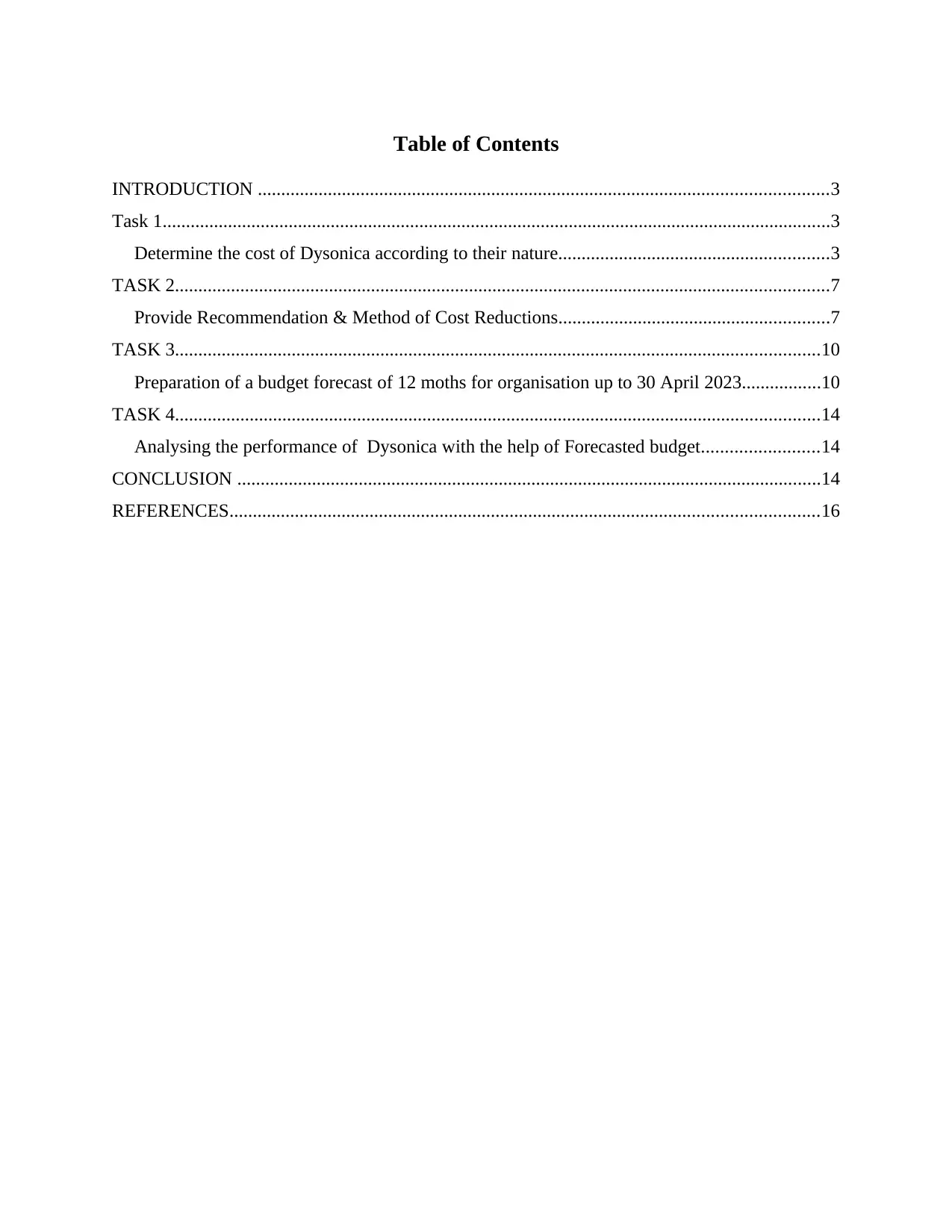
Table of Contents
INTRODUCTION ..........................................................................................................................3
Task 1...............................................................................................................................................3
Determine the cost of Dysonica according to their nature..........................................................3
TASK 2............................................................................................................................................7
Provide Recommendation & Method of Cost Reductions..........................................................7
TASK 3..........................................................................................................................................10
Preparation of a budget forecast of 12 moths for organisation up to 30 April 2023.................10
TASK 4..........................................................................................................................................14
Analysing the performance of Dysonica with the help of Forecasted budget.........................14
CONCLUSION .............................................................................................................................14
REFERENCES..............................................................................................................................16
INTRODUCTION ..........................................................................................................................3
Task 1...............................................................................................................................................3
Determine the cost of Dysonica according to their nature..........................................................3
TASK 2............................................................................................................................................7
Provide Recommendation & Method of Cost Reductions..........................................................7
TASK 3..........................................................................................................................................10
Preparation of a budget forecast of 12 moths for organisation up to 30 April 2023.................10
TASK 4..........................................................................................................................................14
Analysing the performance of Dysonica with the help of Forecasted budget.........................14
CONCLUSION .............................................................................................................................14
REFERENCES..............................................................................................................................16
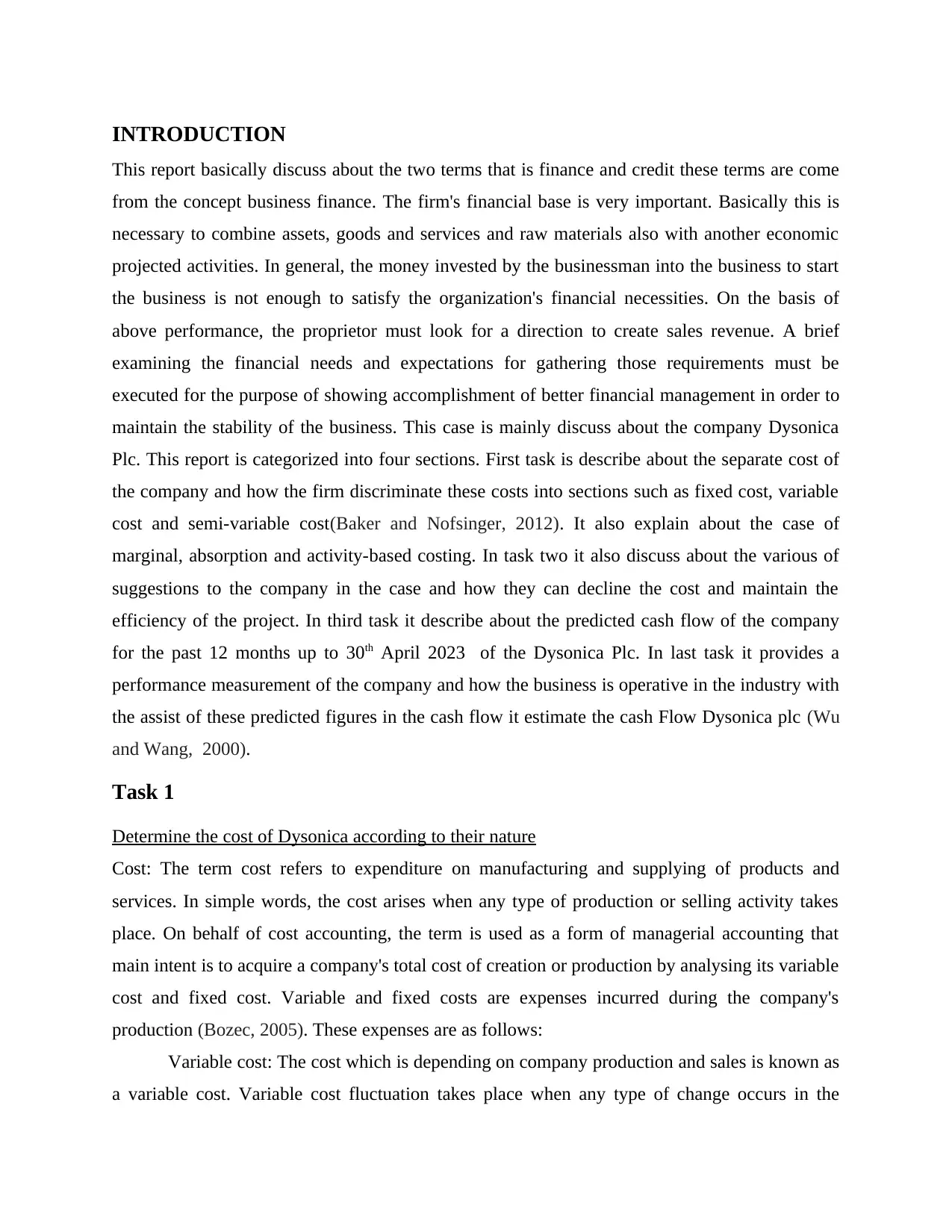
INTRODUCTION
This report basically discuss about the two terms that is finance and credit these terms are come
from the concept business finance. The firm's financial base is very important. Basically this is
necessary to combine assets, goods and services and raw materials also with another economic
projected activities. In general, the money invested by the businessman into the business to start
the business is not enough to satisfy the organization's financial necessities. On the basis of
above performance, the proprietor must look for a direction to create sales revenue. A brief
examining the financial needs and expectations for gathering those requirements must be
executed for the purpose of showing accomplishment of better financial management in order to
maintain the stability of the business. This case is mainly discuss about the company Dysonica
Plc. This report is categorized into four sections. First task is describe about the separate cost of
the company and how the firm discriminate these costs into sections such as fixed cost, variable
cost and semi-variable cost(Baker and Nofsinger, 2012). It also explain about the case of
marginal, absorption and activity-based costing. In task two it also discuss about the various of
suggestions to the company in the case and how they can decline the cost and maintain the
efficiency of the project. In third task it describe about the predicted cash flow of the company
for the past 12 months up to 30th April 2023 of the Dysonica Plc. In last task it provides a
performance measurement of the company and how the business is operative in the industry with
the assist of these predicted figures in the cash flow it estimate the cash Flow Dysonica plc (Wu
and Wang, 2000).
Task 1
Determine the cost of Dysonica according to their nature
Cost: The term cost refers to expenditure on manufacturing and supplying of products and
services. In simple words, the cost arises when any type of production or selling activity takes
place. On behalf of cost accounting, the term is used as a form of managerial accounting that
main intent is to acquire a company's total cost of creation or production by analysing its variable
cost and fixed cost. Variable and fixed costs are expenses incurred during the company's
production (Bozec, 2005). These expenses are as follows:
Variable cost: The cost which is depending on company production and sales is known as
a variable cost. Variable cost fluctuation takes place when any type of change occurs in the
This report basically discuss about the two terms that is finance and credit these terms are come
from the concept business finance. The firm's financial base is very important. Basically this is
necessary to combine assets, goods and services and raw materials also with another economic
projected activities. In general, the money invested by the businessman into the business to start
the business is not enough to satisfy the organization's financial necessities. On the basis of
above performance, the proprietor must look for a direction to create sales revenue. A brief
examining the financial needs and expectations for gathering those requirements must be
executed for the purpose of showing accomplishment of better financial management in order to
maintain the stability of the business. This case is mainly discuss about the company Dysonica
Plc. This report is categorized into four sections. First task is describe about the separate cost of
the company and how the firm discriminate these costs into sections such as fixed cost, variable
cost and semi-variable cost(Baker and Nofsinger, 2012). It also explain about the case of
marginal, absorption and activity-based costing. In task two it also discuss about the various of
suggestions to the company in the case and how they can decline the cost and maintain the
efficiency of the project. In third task it describe about the predicted cash flow of the company
for the past 12 months up to 30th April 2023 of the Dysonica Plc. In last task it provides a
performance measurement of the company and how the business is operative in the industry with
the assist of these predicted figures in the cash flow it estimate the cash Flow Dysonica plc (Wu
and Wang, 2000).
Task 1
Determine the cost of Dysonica according to their nature
Cost: The term cost refers to expenditure on manufacturing and supplying of products and
services. In simple words, the cost arises when any type of production or selling activity takes
place. On behalf of cost accounting, the term is used as a form of managerial accounting that
main intent is to acquire a company's total cost of creation or production by analysing its variable
cost and fixed cost. Variable and fixed costs are expenses incurred during the company's
production (Bozec, 2005). These expenses are as follows:
Variable cost: The cost which is depending on company production and sales is known as
a variable cost. Variable cost fluctuation takes place when any type of change occurs in the
⊘ This is a preview!⊘
Do you want full access?
Subscribe today to unlock all pages.

Trusted by 1+ million students worldwide
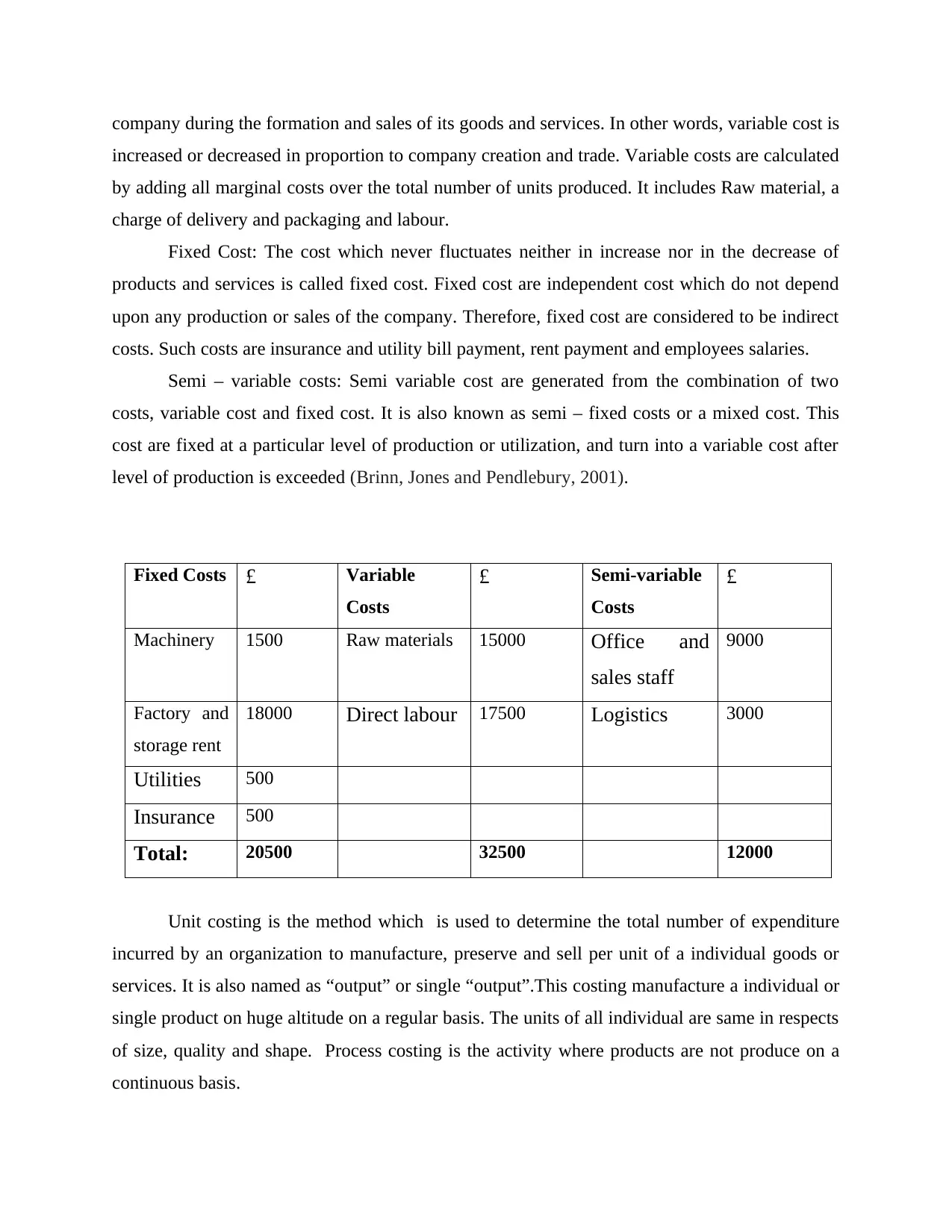
company during the formation and sales of its goods and services. In other words, variable cost is
increased or decreased in proportion to company creation and trade. Variable costs are calculated
by adding all marginal costs over the total number of units produced. It includes Raw material, a
charge of delivery and packaging and labour.
Fixed Cost: The cost which never fluctuates neither in increase nor in the decrease of
products and services is called fixed cost. Fixed cost are independent cost which do not depend
upon any production or sales of the company. Therefore, fixed cost are considered to be indirect
costs. Such costs are insurance and utility bill payment, rent payment and employees salaries.
Semi – variable costs: Semi variable cost are generated from the combination of two
costs, variable cost and fixed cost. It is also known as semi – fixed costs or a mixed cost. This
cost are fixed at a particular level of production or utilization, and turn into a variable cost after
level of production is exceeded (Brinn, Jones and Pendlebury, 2001).
Fixed Costs £ Variable
Costs
£ Semi-variable
Costs
£
Machinery 1500 Raw materials 15000 Office and
sales staff
9000
Factory and
storage rent
18000 Direct labour 17500 Logistics 3000
Utilities 500
Insurance 500
Total: 20500 32500 12000
Unit costing is the method which is used to determine the total number of expenditure
incurred by an organization to manufacture, preserve and sell per unit of a individual goods or
services. It is also named as “output” or single “output”.This costing manufacture a individual or
single product on huge altitude on a regular basis. The units of all individual are same in respects
of size, quality and shape. Process costing is the activity where products are not produce on a
continuous basis.
increased or decreased in proportion to company creation and trade. Variable costs are calculated
by adding all marginal costs over the total number of units produced. It includes Raw material, a
charge of delivery and packaging and labour.
Fixed Cost: The cost which never fluctuates neither in increase nor in the decrease of
products and services is called fixed cost. Fixed cost are independent cost which do not depend
upon any production or sales of the company. Therefore, fixed cost are considered to be indirect
costs. Such costs are insurance and utility bill payment, rent payment and employees salaries.
Semi – variable costs: Semi variable cost are generated from the combination of two
costs, variable cost and fixed cost. It is also known as semi – fixed costs or a mixed cost. This
cost are fixed at a particular level of production or utilization, and turn into a variable cost after
level of production is exceeded (Brinn, Jones and Pendlebury, 2001).
Fixed Costs £ Variable
Costs
£ Semi-variable
Costs
£
Machinery 1500 Raw materials 15000 Office and
sales staff
9000
Factory and
storage rent
18000 Direct labour 17500 Logistics 3000
Utilities 500
Insurance 500
Total: 20500 32500 12000
Unit costing is the method which is used to determine the total number of expenditure
incurred by an organization to manufacture, preserve and sell per unit of a individual goods or
services. It is also named as “output” or single “output”.This costing manufacture a individual or
single product on huge altitude on a regular basis. The units of all individual are same in respects
of size, quality and shape. Process costing is the activity where products are not produce on a
continuous basis.
Paraphrase This Document
Need a fresh take? Get an instant paraphrase of this document with our AI Paraphraser

Absorption Costing: Absorption costing the process which is used to determine the total
cost incurred during the production of a single goods by the method of managerial accounting.
This type of method adopt by the management of the company to consume the product cost. Full
costing is also use as a place of absorption costing. It is not a continuous expenses but it is
capitalized cost that is captured on the balance sheet. In simple words, the absorption costing is
the key to analyse the cost showing accurate details of manufacturing goods and services. AC
also included the direct cost and indirect cost (Firth, 1997). Indirect cost examples are rent of
factory, administration fees and insurance. Direct cost calculate the number of raw materials and
labour are useful in producing the goods (Wong and Selvi, 1998).
Formula of absorption costing are as follows:
Absorption cost = (Direct labour cost + Direct material cost + Variable manufacturing
overhead cost + Fixed manufacturing overhead) / No. of units produced
Illustration of absorption costing:
Let, the company XYZ is a producer and supplier of led bulb. The following data is provided by
the company for single manufacturing face. Use absorption costing method for calculating the
profit of the company.
The total number of unit produced by the company is 20000 and 18000 units are sold
over the period is equal to $ 100 unit price.
Direct Labour is equal to $ 10 and Direct material = $ 40
variable costs is equal to $ 10
Overheads Fixed = $ 10
Fixed cost = $ 60,000
Marginal Costing: Marginal costing is a type of costing where the company perform
activity of allocating variable production to products. It is also say that, this cost which is useful
in measuring the effect of variable cost on the level of production. The major and important part
of marginal cost is break even analysis (Kahya, 1997). There are two types of cost belongs to a
product are variable cost and fixed cost. Variable cost are always changed in accordance of
change in production and sales and fixed cost always remain same or constant. Marginal costing
is the foundation of valuation of finished goods or products and ongoing process of raw material
where fixed cost is recovered from contribution price and variable cost is charged to production.
cost incurred during the production of a single goods by the method of managerial accounting.
This type of method adopt by the management of the company to consume the product cost. Full
costing is also use as a place of absorption costing. It is not a continuous expenses but it is
capitalized cost that is captured on the balance sheet. In simple words, the absorption costing is
the key to analyse the cost showing accurate details of manufacturing goods and services. AC
also included the direct cost and indirect cost (Firth, 1997). Indirect cost examples are rent of
factory, administration fees and insurance. Direct cost calculate the number of raw materials and
labour are useful in producing the goods (Wong and Selvi, 1998).
Formula of absorption costing are as follows:
Absorption cost = (Direct labour cost + Direct material cost + Variable manufacturing
overhead cost + Fixed manufacturing overhead) / No. of units produced
Illustration of absorption costing:
Let, the company XYZ is a producer and supplier of led bulb. The following data is provided by
the company for single manufacturing face. Use absorption costing method for calculating the
profit of the company.
The total number of unit produced by the company is 20000 and 18000 units are sold
over the period is equal to $ 100 unit price.
Direct Labour is equal to $ 10 and Direct material = $ 40
variable costs is equal to $ 10
Overheads Fixed = $ 10
Fixed cost = $ 60,000
Marginal Costing: Marginal costing is a type of costing where the company perform
activity of allocating variable production to products. It is also say that, this cost which is useful
in measuring the effect of variable cost on the level of production. The major and important part
of marginal cost is break even analysis (Kahya, 1997). There are two types of cost belongs to a
product are variable cost and fixed cost. Variable cost are always changed in accordance of
change in production and sales and fixed cost always remain same or constant. Marginal costing
is the foundation of valuation of finished goods or products and ongoing process of raw material
where fixed cost is recovered from contribution price and variable cost is charged to production.

There are some examples of variable production costs are Direct material, direct labour and
direct equipments and few overheads.
Formula of Marginal cost are as follows:
Marginal Cost = Change in Cost/Change in Quantity
here, change in cost refers to rate of fluctuation of variable cost and change in quantity refers to
number of units will increase or decrease at a certain level of production.
Illustration of marginal cost:
Assume that XYZ is a company that produces led bulbs. For calculating the marginal cost
the company uses manufacturing data of products from the following information:
In 1 Month the company produces = 20000 units and second Month it Produced = 30000
Variable Costs of one month = $ 100000 and Variable Costs in Month 2 = $ 160000
Marginal Cost = Change in cost/change in quantity
(160000 – 100000) / (30000 – 20,000) = Marginal Cost
As a result, the marginal cost per unit is equal to $ 6 (60000/10000).
Activity Based costing: It is the method of costing which is useful in analysing practices in an
organization and fixing the cost of activity to products and services on behalf of the real and
accurate consumption by each. It is cost which is very helpful at the time of business
manufacturing large number of overheads. In result, it shows the true and fair value of the
company expenditure (Klusek and Bornstein, 2006). The activity based costing is also gives
knowledge of a particular goods production cost breakdown and also helpful in finding a
individual product which is profitable of an organization. There are some measures of activity
based costing:
It consider both the costs, direct cost and overhead costs of manufacturing each and every
product.
Activity based costing is useful in remembering different indirect expenses required in
different type of products.
The prices are very accurate and exact straight about spending and price your products.
Keeping in mind how the cost can be deducted or lower.
The ABC organization determines the path of distribution are used by the seller to sell
their product or services to consumers, such as wholesaler, social networking site,
advertisement and door to door services.
direct equipments and few overheads.
Formula of Marginal cost are as follows:
Marginal Cost = Change in Cost/Change in Quantity
here, change in cost refers to rate of fluctuation of variable cost and change in quantity refers to
number of units will increase or decrease at a certain level of production.
Illustration of marginal cost:
Assume that XYZ is a company that produces led bulbs. For calculating the marginal cost
the company uses manufacturing data of products from the following information:
In 1 Month the company produces = 20000 units and second Month it Produced = 30000
Variable Costs of one month = $ 100000 and Variable Costs in Month 2 = $ 160000
Marginal Cost = Change in cost/change in quantity
(160000 – 100000) / (30000 – 20,000) = Marginal Cost
As a result, the marginal cost per unit is equal to $ 6 (60000/10000).
Activity Based costing: It is the method of costing which is useful in analysing practices in an
organization and fixing the cost of activity to products and services on behalf of the real and
accurate consumption by each. It is cost which is very helpful at the time of business
manufacturing large number of overheads. In result, it shows the true and fair value of the
company expenditure (Klusek and Bornstein, 2006). The activity based costing is also gives
knowledge of a particular goods production cost breakdown and also helpful in finding a
individual product which is profitable of an organization. There are some measures of activity
based costing:
It consider both the costs, direct cost and overhead costs of manufacturing each and every
product.
Activity based costing is useful in remembering different indirect expenses required in
different type of products.
The prices are very accurate and exact straight about spending and price your products.
Keeping in mind how the cost can be deducted or lower.
The ABC organization determines the path of distribution are used by the seller to sell
their product or services to consumers, such as wholesaler, social networking site,
advertisement and door to door services.
⊘ This is a preview!⊘
Do you want full access?
Subscribe today to unlock all pages.

Trusted by 1+ million students worldwide
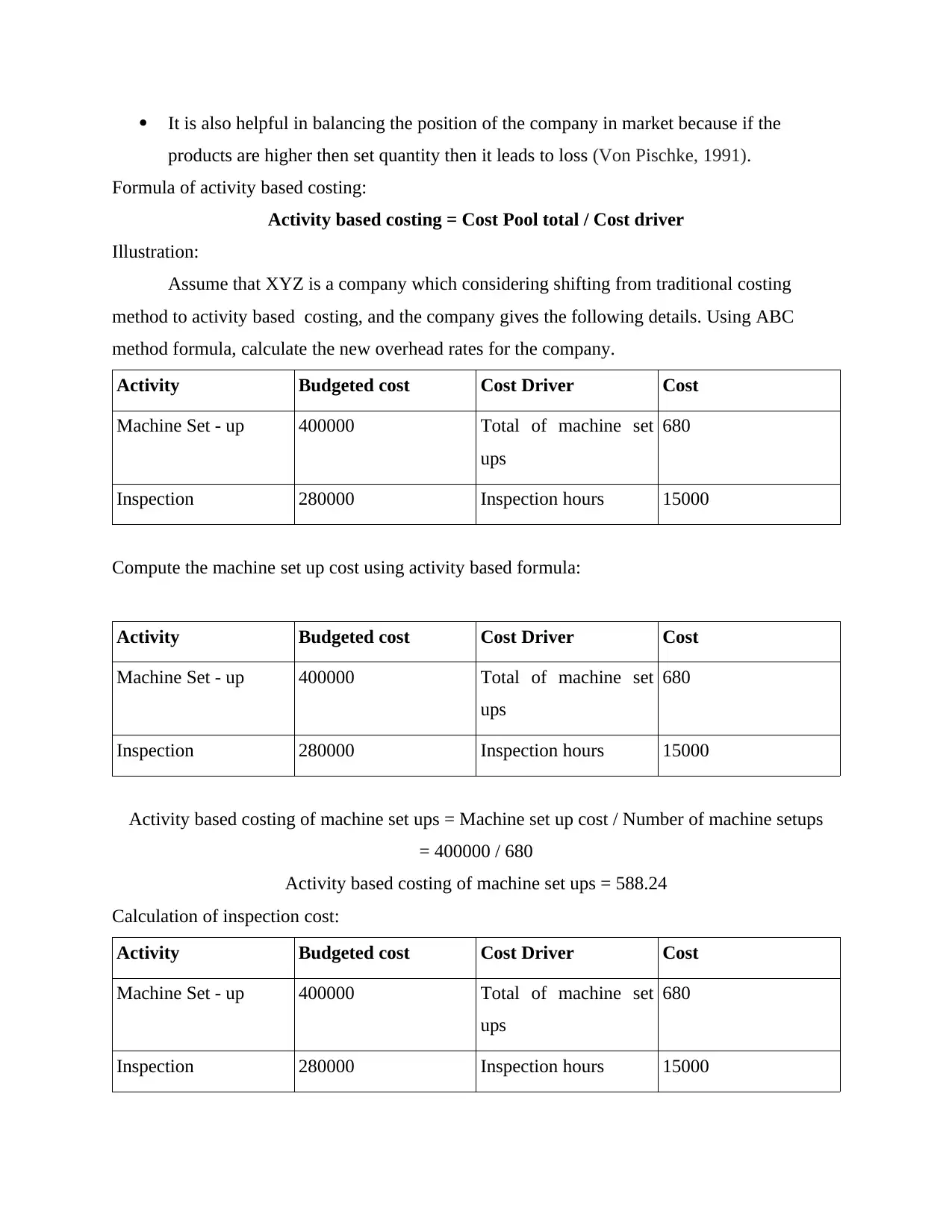
It is also helpful in balancing the position of the company in market because if the
products are higher then set quantity then it leads to loss (Von Pischke, 1991).
Formula of activity based costing:
Activity based costing = Cost Pool total / Cost driver
Illustration:
Assume that XYZ is a company which considering shifting from traditional costing
method to activity based costing, and the company gives the following details. Using ABC
method formula, calculate the new overhead rates for the company.
Activity Budgeted cost Cost Driver Cost
Machine Set - up 400000 Total of machine set
ups
680
Inspection 280000 Inspection hours 15000
Compute the machine set up cost using activity based formula:
Activity Budgeted cost Cost Driver Cost
Machine Set - up 400000 Total of machine set
ups
680
Inspection 280000 Inspection hours 15000
Activity based costing of machine set ups = Machine set up cost / Number of machine setups
= 400000 / 680
Activity based costing of machine set ups = 588.24
Calculation of inspection cost:
Activity Budgeted cost Cost Driver Cost
Machine Set - up 400000 Total of machine set
ups
680
Inspection 280000 Inspection hours 15000
products are higher then set quantity then it leads to loss (Von Pischke, 1991).
Formula of activity based costing:
Activity based costing = Cost Pool total / Cost driver
Illustration:
Assume that XYZ is a company which considering shifting from traditional costing
method to activity based costing, and the company gives the following details. Using ABC
method formula, calculate the new overhead rates for the company.
Activity Budgeted cost Cost Driver Cost
Machine Set - up 400000 Total of machine set
ups
680
Inspection 280000 Inspection hours 15000
Compute the machine set up cost using activity based formula:
Activity Budgeted cost Cost Driver Cost
Machine Set - up 400000 Total of machine set
ups
680
Inspection 280000 Inspection hours 15000
Activity based costing of machine set ups = Machine set up cost / Number of machine setups
= 400000 / 680
Activity based costing of machine set ups = 588.24
Calculation of inspection cost:
Activity Budgeted cost Cost Driver Cost
Machine Set - up 400000 Total of machine set
ups
680
Inspection 280000 Inspection hours 15000
Paraphrase This Document
Need a fresh take? Get an instant paraphrase of this document with our AI Paraphraser
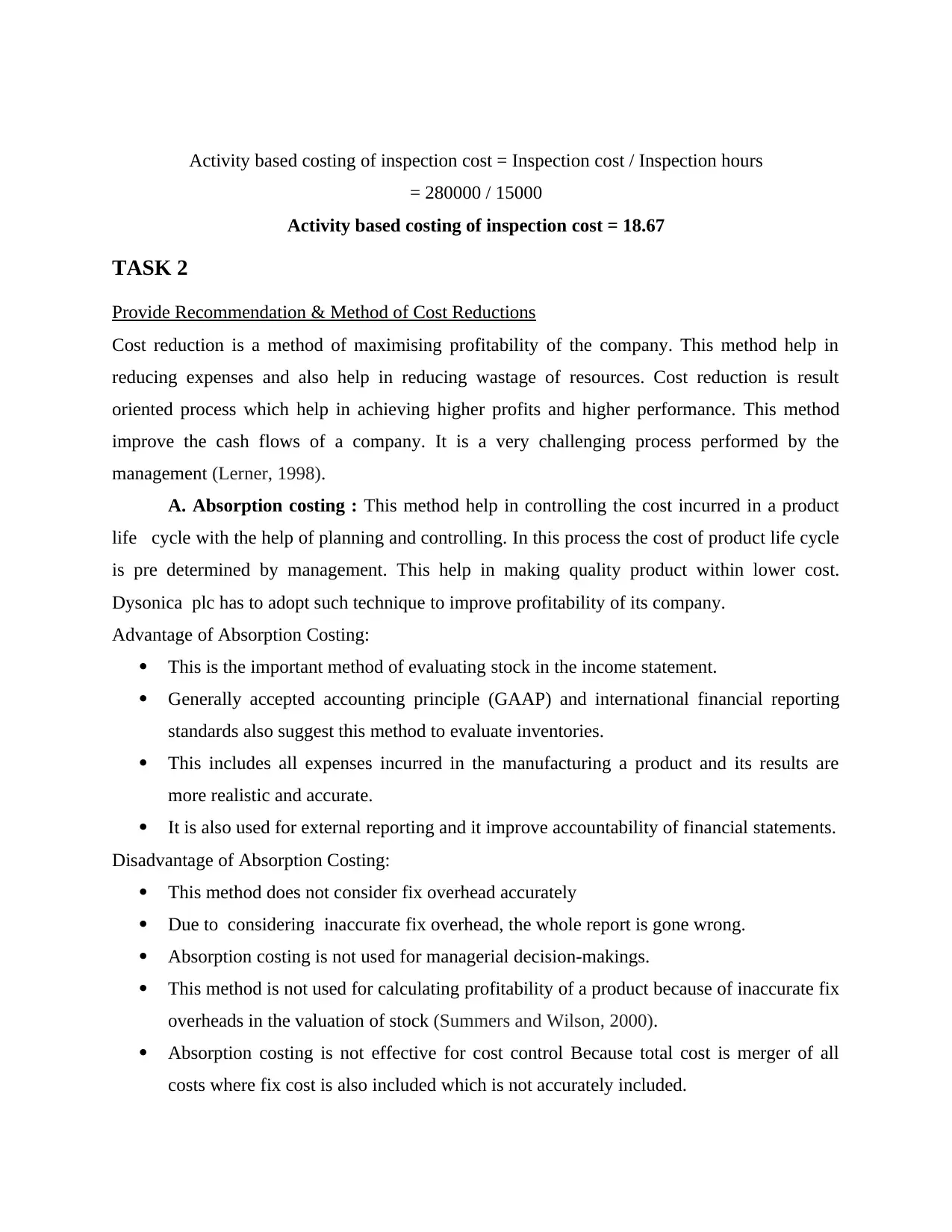
Activity based costing of inspection cost = Inspection cost / Inspection hours
= 280000 / 15000
Activity based costing of inspection cost = 18.67
TASK 2
Provide Recommendation & Method of Cost Reductions
Cost reduction is a method of maximising profitability of the company. This method help in
reducing expenses and also help in reducing wastage of resources. Cost reduction is result
oriented process which help in achieving higher profits and higher performance. This method
improve the cash flows of a company. It is a very challenging process performed by the
management (Lerner, 1998).
A. Absorption costing : This method help in controlling the cost incurred in a product
life cycle with the help of planning and controlling. In this process the cost of product life cycle
is pre determined by management. This help in making quality product within lower cost.
Dysonica plc has to adopt such technique to improve profitability of its company.
Advantage of Absorption Costing:
This is the important method of evaluating stock in the income statement.
Generally accepted accounting principle (GAAP) and international financial reporting
standards also suggest this method to evaluate inventories.
This includes all expenses incurred in the manufacturing a product and its results are
more realistic and accurate.
It is also used for external reporting and it improve accountability of financial statements.
Disadvantage of Absorption Costing:
This method does not consider fix overhead accurately
Due to considering inaccurate fix overhead, the whole report is gone wrong.
Absorption costing is not used for managerial decision-makings.
This method is not used for calculating profitability of a product because of inaccurate fix
overheads in the valuation of stock (Summers and Wilson, 2000).
Absorption costing is not effective for cost control Because total cost is merger of all
costs where fix cost is also included which is not accurately included.
= 280000 / 15000
Activity based costing of inspection cost = 18.67
TASK 2
Provide Recommendation & Method of Cost Reductions
Cost reduction is a method of maximising profitability of the company. This method help in
reducing expenses and also help in reducing wastage of resources. Cost reduction is result
oriented process which help in achieving higher profits and higher performance. This method
improve the cash flows of a company. It is a very challenging process performed by the
management (Lerner, 1998).
A. Absorption costing : This method help in controlling the cost incurred in a product
life cycle with the help of planning and controlling. In this process the cost of product life cycle
is pre determined by management. This help in making quality product within lower cost.
Dysonica plc has to adopt such technique to improve profitability of its company.
Advantage of Absorption Costing:
This is the important method of evaluating stock in the income statement.
Generally accepted accounting principle (GAAP) and international financial reporting
standards also suggest this method to evaluate inventories.
This includes all expenses incurred in the manufacturing a product and its results are
more realistic and accurate.
It is also used for external reporting and it improve accountability of financial statements.
Disadvantage of Absorption Costing:
This method does not consider fix overhead accurately
Due to considering inaccurate fix overhead, the whole report is gone wrong.
Absorption costing is not used for managerial decision-makings.
This method is not used for calculating profitability of a product because of inaccurate fix
overheads in the valuation of stock (Summers and Wilson, 2000).
Absorption costing is not effective for cost control Because total cost is merger of all
costs where fix cost is also included which is not accurately included.
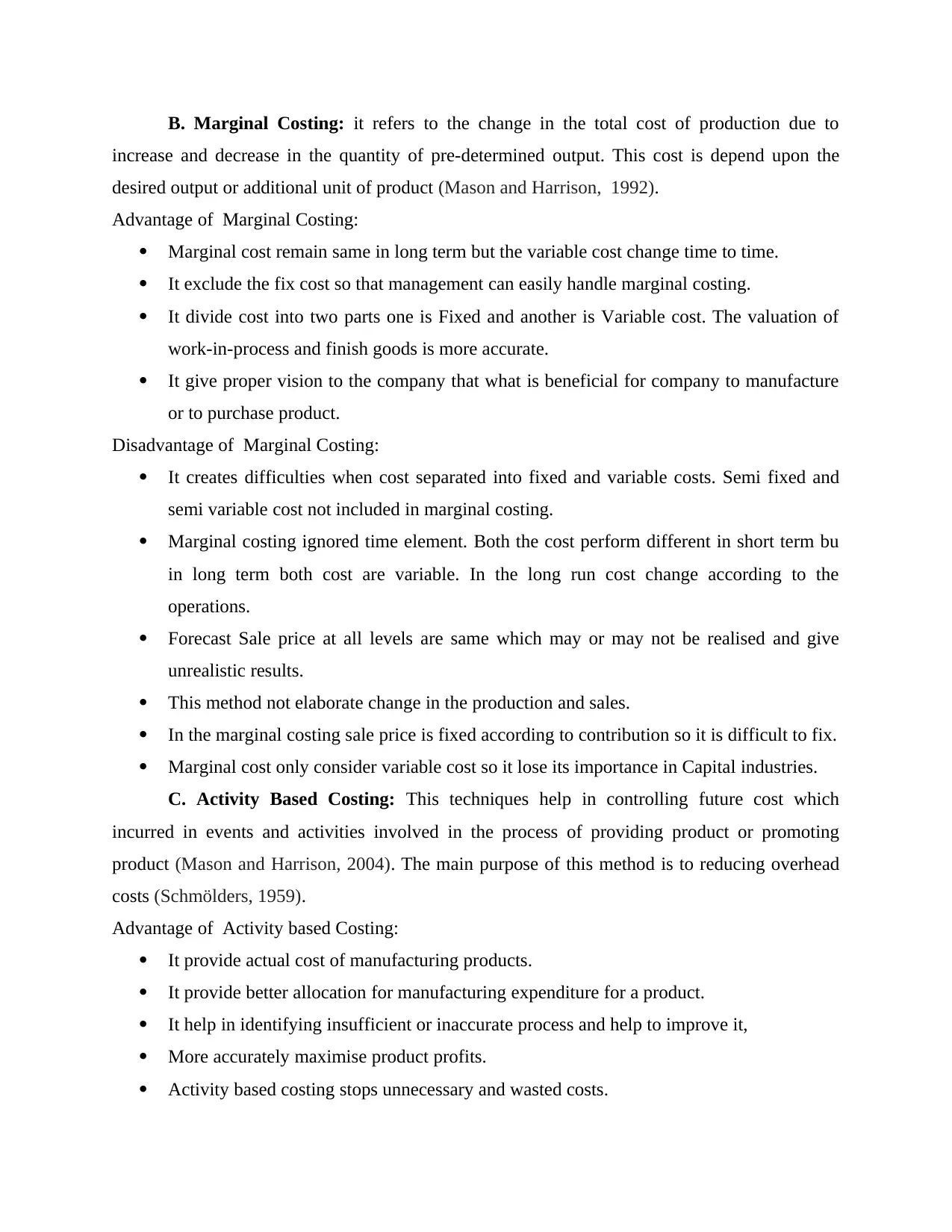
B. Marginal Costing: it refers to the change in the total cost of production due to
increase and decrease in the quantity of pre-determined output. This cost is depend upon the
desired output or additional unit of product (Mason and Harrison, 1992).
Advantage of Marginal Costing:
Marginal cost remain same in long term but the variable cost change time to time.
It exclude the fix cost so that management can easily handle marginal costing.
It divide cost into two parts one is Fixed and another is Variable cost. The valuation of
work-in-process and finish goods is more accurate.
It give proper vision to the company that what is beneficial for company to manufacture
or to purchase product.
Disadvantage of Marginal Costing:
It creates difficulties when cost separated into fixed and variable costs. Semi fixed and
semi variable cost not included in marginal costing.
Marginal costing ignored time element. Both the cost perform different in short term bu
in long term both cost are variable. In the long run cost change according to the
operations.
Forecast Sale price at all levels are same which may or may not be realised and give
unrealistic results.
This method not elaborate change in the production and sales.
In the marginal costing sale price is fixed according to contribution so it is difficult to fix.
Marginal cost only consider variable cost so it lose its importance in Capital industries.
C. Activity Based Costing: This techniques help in controlling future cost which
incurred in events and activities involved in the process of providing product or promoting
product (Mason and Harrison, 2004). The main purpose of this method is to reducing overhead
costs (Schmölders, 1959).
Advantage of Activity based Costing:
It provide actual cost of manufacturing products.
It provide better allocation for manufacturing expenditure for a product.
It help in identifying insufficient or inaccurate process and help to improve it,
More accurately maximise product profits.
Activity based costing stops unnecessary and wasted costs.
increase and decrease in the quantity of pre-determined output. This cost is depend upon the
desired output or additional unit of product (Mason and Harrison, 1992).
Advantage of Marginal Costing:
Marginal cost remain same in long term but the variable cost change time to time.
It exclude the fix cost so that management can easily handle marginal costing.
It divide cost into two parts one is Fixed and another is Variable cost. The valuation of
work-in-process and finish goods is more accurate.
It give proper vision to the company that what is beneficial for company to manufacture
or to purchase product.
Disadvantage of Marginal Costing:
It creates difficulties when cost separated into fixed and variable costs. Semi fixed and
semi variable cost not included in marginal costing.
Marginal costing ignored time element. Both the cost perform different in short term bu
in long term both cost are variable. In the long run cost change according to the
operations.
Forecast Sale price at all levels are same which may or may not be realised and give
unrealistic results.
This method not elaborate change in the production and sales.
In the marginal costing sale price is fixed according to contribution so it is difficult to fix.
Marginal cost only consider variable cost so it lose its importance in Capital industries.
C. Activity Based Costing: This techniques help in controlling future cost which
incurred in events and activities involved in the process of providing product or promoting
product (Mason and Harrison, 2004). The main purpose of this method is to reducing overhead
costs (Schmölders, 1959).
Advantage of Activity based Costing:
It provide actual cost of manufacturing products.
It provide better allocation for manufacturing expenditure for a product.
It help in identifying insufficient or inaccurate process and help to improve it,
More accurately maximise product profits.
Activity based costing stops unnecessary and wasted costs.
⊘ This is a preview!⊘
Do you want full access?
Subscribe today to unlock all pages.

Trusted by 1+ million students worldwide
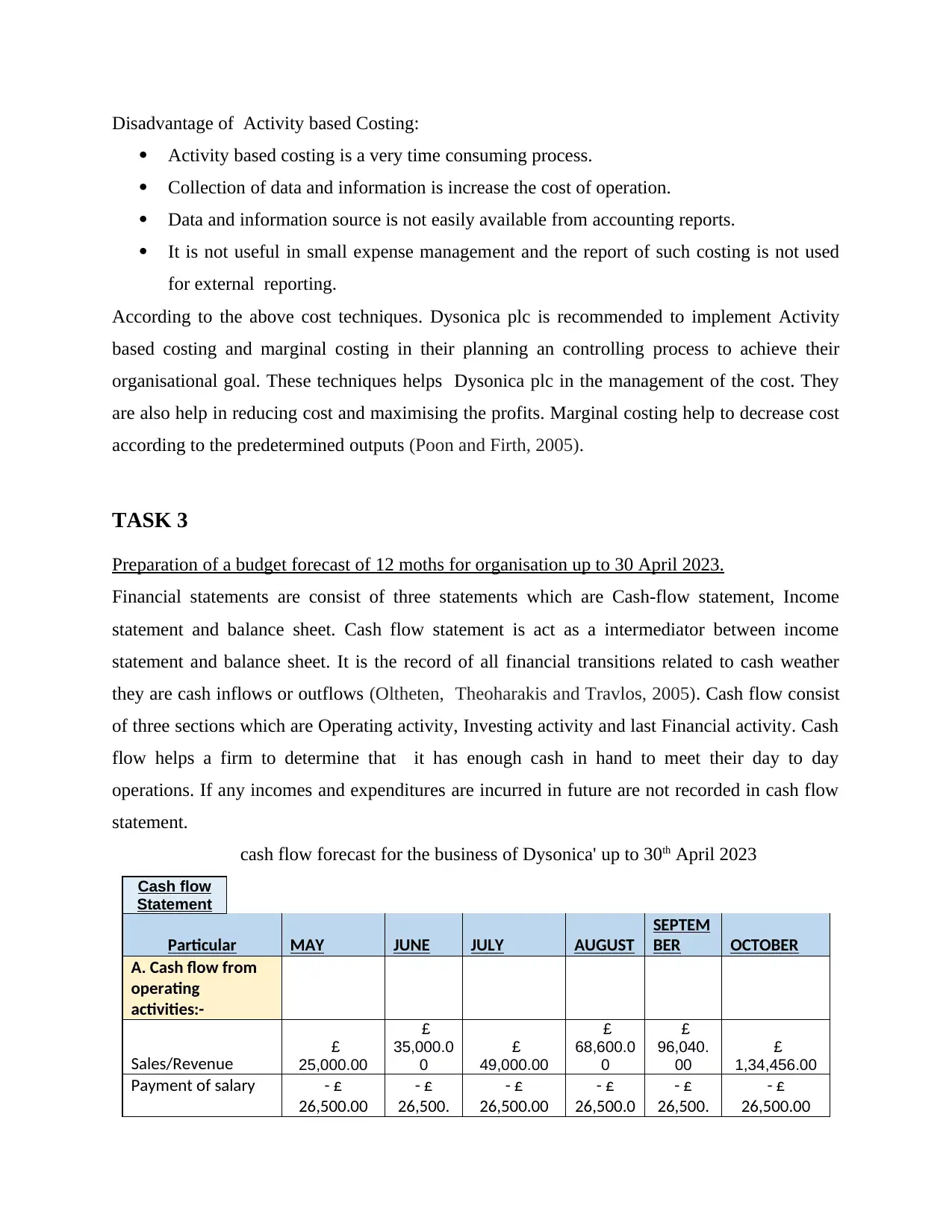
Disadvantage of Activity based Costing:
Activity based costing is a very time consuming process.
Collection of data and information is increase the cost of operation.
Data and information source is not easily available from accounting reports.
It is not useful in small expense management and the report of such costing is not used
for external reporting.
According to the above cost techniques. Dysonica plc is recommended to implement Activity
based costing and marginal costing in their planning an controlling process to achieve their
organisational goal. These techniques helps Dysonica plc in the management of the cost. They
are also help in reducing cost and maximising the profits. Marginal costing help to decrease cost
according to the predetermined outputs (Poon and Firth, 2005).
TASK 3
Preparation of a budget forecast of 12 moths for organisation up to 30 April 2023.
Financial statements are consist of three statements which are Cash-flow statement, Income
statement and balance sheet. Cash flow statement is act as a intermediator between income
statement and balance sheet. It is the record of all financial transitions related to cash weather
they are cash inflows or outflows (Oltheten, Theoharakis and Travlos, 2005). Cash flow consist
of three sections which are Operating activity, Investing activity and last Financial activity. Cash
flow helps a firm to determine that it has enough cash in hand to meet their day to day
operations. If any incomes and expenditures are incurred in future are not recorded in cash flow
statement.
cash flow forecast for the business of Dysonica' up to 30th April 2023
Cash flow
Statement
Particular MAY JUNE JULY AUGUST
SEPTEM
BER OCTOBER
A. Cash flow from
operating
activities:-
Sales/Revenue £
25,000.00
£
35,000.0
0
£
49,000.00
£
68,600.0
0
£
96,040.
00
£
1,34,456.00
Payment of salary - £
26,500.00
- £
26,500.
- £
26,500.00
- £
26,500.0
- £
26,500.
- £
26,500.00
Activity based costing is a very time consuming process.
Collection of data and information is increase the cost of operation.
Data and information source is not easily available from accounting reports.
It is not useful in small expense management and the report of such costing is not used
for external reporting.
According to the above cost techniques. Dysonica plc is recommended to implement Activity
based costing and marginal costing in their planning an controlling process to achieve their
organisational goal. These techniques helps Dysonica plc in the management of the cost. They
are also help in reducing cost and maximising the profits. Marginal costing help to decrease cost
according to the predetermined outputs (Poon and Firth, 2005).
TASK 3
Preparation of a budget forecast of 12 moths for organisation up to 30 April 2023.
Financial statements are consist of three statements which are Cash-flow statement, Income
statement and balance sheet. Cash flow statement is act as a intermediator between income
statement and balance sheet. It is the record of all financial transitions related to cash weather
they are cash inflows or outflows (Oltheten, Theoharakis and Travlos, 2005). Cash flow consist
of three sections which are Operating activity, Investing activity and last Financial activity. Cash
flow helps a firm to determine that it has enough cash in hand to meet their day to day
operations. If any incomes and expenditures are incurred in future are not recorded in cash flow
statement.
cash flow forecast for the business of Dysonica' up to 30th April 2023
Cash flow
Statement
Particular MAY JUNE JULY AUGUST
SEPTEM
BER OCTOBER
A. Cash flow from
operating
activities:-
Sales/Revenue £
25,000.00
£
35,000.0
0
£
49,000.00
£
68,600.0
0
£
96,040.
00
£
1,34,456.00
Payment of salary - £
26,500.00
- £
26,500.
- £
26,500.00
- £
26,500.0
- £
26,500.
- £
26,500.00
Paraphrase This Document
Need a fresh take? Get an instant paraphrase of this document with our AI Paraphraser
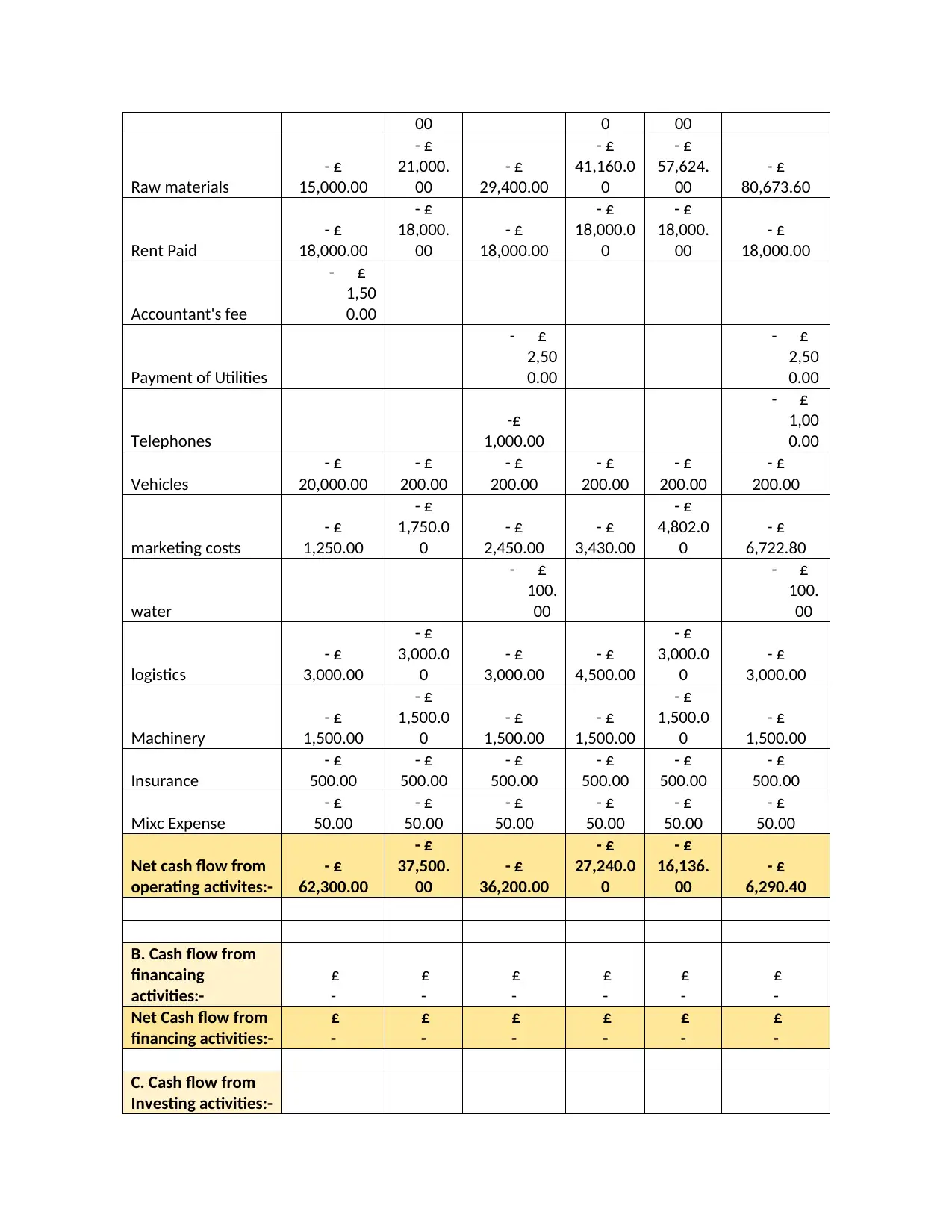
00 0 00
Raw materials
- £
15,000.00
- £
21,000.
00
- £
29,400.00
- £
41,160.0
0
- £
57,624.
00
- £
80,673.60
Rent Paid
- £
18,000.00
- £
18,000.
00
- £
18,000.00
- £
18,000.0
0
- £
18,000.
00
- £
18,000.00
Accountant's fee
- £
1,50
0.00
Payment of Utilities
- £
2,50
0.00
- £
2,50
0.00
Telephones
-£
1,000.00
- £
1,00
0.00
Vehicles
- £
20,000.00
- £
200.00
- £
200.00
- £
200.00
- £
200.00
- £
200.00
marketing costs
- £
1,250.00
- £
1,750.0
0
- £
2,450.00
- £
3,430.00
- £
4,802.0
0
- £
6,722.80
water
- £
100.
00
- £
100.
00
logistics
- £
3,000.00
- £
3,000.0
0
- £
3,000.00
- £
4,500.00
- £
3,000.0
0
- £
3,000.00
Machinery
- £
1,500.00
- £
1,500.0
0
- £
1,500.00
- £
1,500.00
- £
1,500.0
0
- £
1,500.00
Insurance
- £
500.00
- £
500.00
- £
500.00
- £
500.00
- £
500.00
- £
500.00
Mixc Expense
- £
50.00
- £
50.00
- £
50.00
- £
50.00
- £
50.00
- £
50.00
Net cash flow from
operating activites:-
- £
62,300.00
- £
37,500.
00
- £
36,200.00
- £
27,240.0
0
- £
16,136.
00
- £
6,290.40
B. Cash flow from
financaing
activities:-
£
-
£
-
£
-
£
-
£
-
£
-
Net Cash flow from
financing activities:-
£
-
£
-
£
-
£
-
£
-
£
-
C. Cash flow from
Investing activities:-
Raw materials
- £
15,000.00
- £
21,000.
00
- £
29,400.00
- £
41,160.0
0
- £
57,624.
00
- £
80,673.60
Rent Paid
- £
18,000.00
- £
18,000.
00
- £
18,000.00
- £
18,000.0
0
- £
18,000.
00
- £
18,000.00
Accountant's fee
- £
1,50
0.00
Payment of Utilities
- £
2,50
0.00
- £
2,50
0.00
Telephones
-£
1,000.00
- £
1,00
0.00
Vehicles
- £
20,000.00
- £
200.00
- £
200.00
- £
200.00
- £
200.00
- £
200.00
marketing costs
- £
1,250.00
- £
1,750.0
0
- £
2,450.00
- £
3,430.00
- £
4,802.0
0
- £
6,722.80
water
- £
100.
00
- £
100.
00
logistics
- £
3,000.00
- £
3,000.0
0
- £
3,000.00
- £
4,500.00
- £
3,000.0
0
- £
3,000.00
Machinery
- £
1,500.00
- £
1,500.0
0
- £
1,500.00
- £
1,500.00
- £
1,500.0
0
- £
1,500.00
Insurance
- £
500.00
- £
500.00
- £
500.00
- £
500.00
- £
500.00
- £
500.00
Mixc Expense
- £
50.00
- £
50.00
- £
50.00
- £
50.00
- £
50.00
- £
50.00
Net cash flow from
operating activites:-
- £
62,300.00
- £
37,500.
00
- £
36,200.00
- £
27,240.0
0
- £
16,136.
00
- £
6,290.40
B. Cash flow from
financaing
activities:-
£
-
£
-
£
-
£
-
£
-
£
-
Net Cash flow from
financing activities:-
£
-
£
-
£
-
£
-
£
-
£
-
C. Cash flow from
Investing activities:-
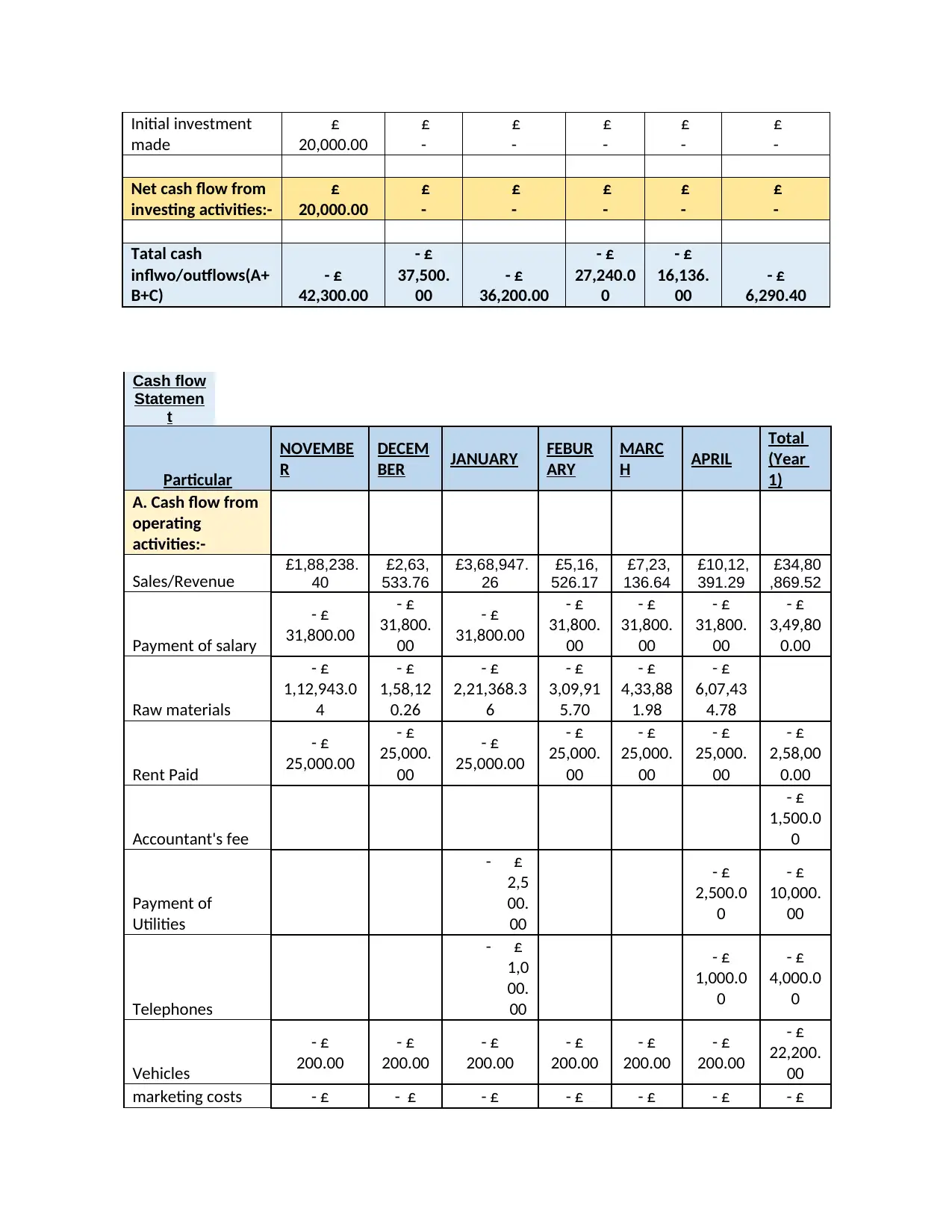
Initial investment
made
£
20,000.00
£
-
£
-
£
-
£
-
£
-
Net cash flow from
investing activities:-
£
20,000.00
£
-
£
-
£
-
£
-
£
-
Tatal cash
inflwo/outflows(A+
B+C)
- £
42,300.00
- £
37,500.
00
- £
36,200.00
- £
27,240.0
0
- £
16,136.
00
- £
6,290.40
Cash flow
Statemen
t
Particular
NOVEMBE
R
DECEM
BER JANUARY FEBUR
ARY
MARC
H APRIL
Total
(Year
1)
A. Cash flow from
operating
activities:-
Sales/Revenue £1,88,238.
40
£2,63,
533.76
£3,68,947.
26
£5,16,
526.17
£7,23,
136.64
£10,12,
391.29
£34,80
,869.52
Payment of salary
- £
31,800.00
- £
31,800.
00
- £
31,800.00
- £
31,800.
00
- £
31,800.
00
- £
31,800.
00
- £
3,49,80
0.00
Raw materials
- £
1,12,943.0
4
- £
1,58,12
0.26
- £
2,21,368.3
6
- £
3,09,91
5.70
- £
4,33,88
1.98
- £
6,07,43
4.78
Rent Paid
- £
25,000.00
- £
25,000.
00
- £
25,000.00
- £
25,000.
00
- £
25,000.
00
- £
25,000.
00
- £
2,58,00
0.00
Accountant's fee
- £
1,500.0
0
Payment of
Utilities
- £
2,5
00.
00
- £
2,500.0
0
- £
10,000.
00
Telephones
- £
1,0
00.
00
- £
1,000.0
0
- £
4,000.0
0
Vehicles
- £
200.00
- £
200.00
- £
200.00
- £
200.00
- £
200.00
- £
200.00
- £
22,200.
00
marketing costs - £ - £ - £ - £ - £ - £ - £
made
£
20,000.00
£
-
£
-
£
-
£
-
£
-
Net cash flow from
investing activities:-
£
20,000.00
£
-
£
-
£
-
£
-
£
-
Tatal cash
inflwo/outflows(A+
B+C)
- £
42,300.00
- £
37,500.
00
- £
36,200.00
- £
27,240.0
0
- £
16,136.
00
- £
6,290.40
Cash flow
Statemen
t
Particular
NOVEMBE
R
DECEM
BER JANUARY FEBUR
ARY
MARC
H APRIL
Total
(Year
1)
A. Cash flow from
operating
activities:-
Sales/Revenue £1,88,238.
40
£2,63,
533.76
£3,68,947.
26
£5,16,
526.17
£7,23,
136.64
£10,12,
391.29
£34,80
,869.52
Payment of salary
- £
31,800.00
- £
31,800.
00
- £
31,800.00
- £
31,800.
00
- £
31,800.
00
- £
31,800.
00
- £
3,49,80
0.00
Raw materials
- £
1,12,943.0
4
- £
1,58,12
0.26
- £
2,21,368.3
6
- £
3,09,91
5.70
- £
4,33,88
1.98
- £
6,07,43
4.78
Rent Paid
- £
25,000.00
- £
25,000.
00
- £
25,000.00
- £
25,000.
00
- £
25,000.
00
- £
25,000.
00
- £
2,58,00
0.00
Accountant's fee
- £
1,500.0
0
Payment of
Utilities
- £
2,5
00.
00
- £
2,500.0
0
- £
10,000.
00
Telephones
- £
1,0
00.
00
- £
1,000.0
0
- £
4,000.0
0
Vehicles
- £
200.00
- £
200.00
- £
200.00
- £
200.00
- £
200.00
- £
200.00
- £
22,200.
00
marketing costs - £ - £ - £ - £ - £ - £ - £
⊘ This is a preview!⊘
Do you want full access?
Subscribe today to unlock all pages.

Trusted by 1+ million students worldwide
1 out of 16
Related Documents
Your All-in-One AI-Powered Toolkit for Academic Success.
+13062052269
info@desklib.com
Available 24*7 on WhatsApp / Email
![[object Object]](/_next/static/media/star-bottom.7253800d.svg)
Unlock your academic potential
Copyright © 2020–2025 A2Z Services. All Rights Reserved. Developed and managed by ZUCOL.





